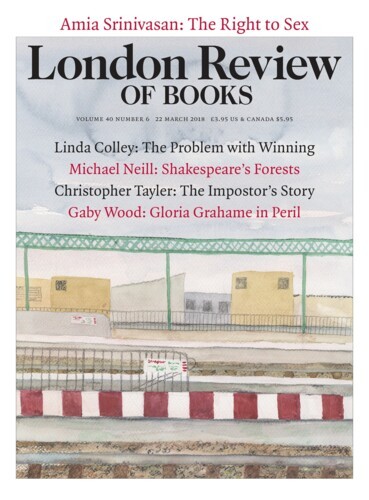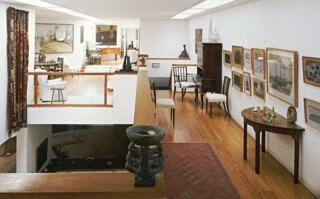Jim Ede had been living abroad – first Tangier, then the Loire – when he found himself ‘dreaming of the idea of somehow creating a living place where works of art could be enjoyed, inherent to the domestic setting, where young people could be at home unhampered by the greater austerity of the museum or public art gallery, and where an informality might infuse an underlying formality’. In his book A Way of Life (1984), he writes of wanting, ‘in a modest way, to use the inspiration I had had from beautiful interiors, houses of leisured elegance’. He knew all about beautiful interiors. He had made sure to have his own in Morocco and France; and while working at the Tate in the 1920s and early 1930s, he and his wife, Helen, had lived in Hampstead, where Braque, Naum Gabo, Diaghilev and Nijinksky were among their many visitors – along with artist friends from closer to home, particularly Ben and Winifred Nicholson.
In 1956, the Edes returned to England and Jim started looking for a suitable building. He wanted to buy a former stately home but didn’t have the money. Eventually, he found four small condemned slum cottages in the north of Cambridge. With the help of the architect Roland Aldridge he knocked them together and added two bay windows to create a greater sense of space and light – a hint of St Ives in the gloom of East Anglia. He built a bridge over a passageway and had a spiral staircase installed inside a semi-circular tower. He painted the internal walls white, laid floorboards reclaimed from a 17th-century house and set about filling the place with the found objects and pieces of furniture he felt worked best with his art collection. The collection itself had taken a while to acquire, much of it coming through friendships, or as gifts from the artists or their families – the first inscription Eric Gill ever made; a Miró – as he got hold of whatever people would let him have:
I turned out to be one of Ben Nicholson’s very few admirers at that time, and after he had tried to sell a painting for a year or so he would tell me that I could have it for the price of the canvas and frame, usually one to three pounds. I could not always manage it, for my salary was under £250 a year; not much to maintain a family in London. Many he would give me, and now that Kettle’s Yard has been catalogued I find it has 44 works of his, and many others have been given away.
He never paid much for Alfred Wallis’s paintings either:
I think it was in 1926 I first began to get paintings by Alfred Wallis. They would come by post, perhaps sixty at a time, and the price fixed at 1/-, 2/-, 3/-, according to size. I once got as many as twenty but usually could not afford so many. I suppose that Kettle’s Yard now has a hundred. In looking back it is odd to remember how few people even wanted one as a gift, their children could do so much better.
At Kettle’s Yard, which has just reopened after a two-year refit, the art is everywhere, part of the texture of the house. A Brancusi head sits on top of a grand piano; a Ben Nicholson hangs at knee height under a window; the attic is devoted to Gaudier-Brzeska sketches. While the house was being repainted and a few repairs carried out, the curators used the time to restore some of the collection. Ede’s approach to conservation had included giving a painting ‘a good scrubbing’, and he had his Alfred Wallises cheaply and conveniently mounted at a local hardware shop – some of them were on asbestos board, so they’ve now been reframed. Winifred Nicholson’s Seascape (Sea and Sand) was also restored, though the team were careful not to smarten up its blue-green frame too much; it remains tastefully distressed.
The house is still presented much as the Edes left it. Before the recent building works began, each object was carefully measured in its position so that it could be returned to exactly the same spot. The grand piano was discovered to have a dent in the surface from where the Brancusi head had sat in one place for so long. The narrow elm dining table remains in its proper alcove; nearby, there’s the pewter plate with the single pale yellow lemon (replaced every Friday) chosen to match the yellow oval in the Miró painting that hangs nearby, and the yellow of the flowers in the Christopher Wood picture opposite. On a low table in Jim’s bedroom there’s a spiral of grey and white pebbles in a perfect grading of colour and size. Everything demands to be touched, and can’t be: visiting is excruciating, in the best way. Against one wall rests the Queen Anne bureau Ede bought for £8 when he was 12, much more to the taste of the kind of boy he was than the ‘first-class bicycle’ he could have got for the money instead. The Edes’ kitchen was small and spartan; it’s now a tiny staff room. Jim and Helen barely used it: one of their visitors, Duncan Robinson, remembered their ‘austere, almost invalid evening meal’, sometimes followed by their two indulgences: ‘very dark bitter chocolate, eaten in very small quantities’, and the occasional half bottle of burgundy or claret, kept in a cupboard under the stairs.
In 1966 the Edes gave the house and its contents to the University of Cambridge, but stayed on for a while as live-in curators. In 1970 a new modernist extension was added, by Leslie Martin and David Owers, to show off more of the work in a larger space with more generous sofas. The latest development – funded by £3.65 million from Arts Council England and £2.32 million from the Heritage Lottery Fund – has involved entirely remodelling and expanding the gallery, on Castle Street, that sits in front of the house, in a way that is inspired by the 1970 extension. The architect, Jamie Fobert, who redesigned Tate St Ives and who is about to start work on the National Portrait Gallery, describes the extension as ‘a masterpiece of late modern architecture’. He wanted something of its look and sensibility – roof-lights, height, mezzanine views of the area below – for the tall temporary exhibition spaces, education area, café and shop that every museum and gallery must now have. But despite the new glass entranceway and floor-to-ceiling window over the street, the overall meandering journey around Kettle’s Yard has been maintained. To visit the house itself you still have to walk down a narrow passageway and ring a bell on a pulley (though you now need to get a timed ticket from reception first). When the Edes lived there, the pulley was a fishing-net cork on the end of a rope; the curators are hunting for a similar one to replace it. (The bell is original, nabbed from the servants’ corridor of a grand house in Scotland.) After ringing, you wait for someone to open the double doors to let you in. In 1958, that would have been Jim Ede, who admitted visitors every afternoon between two and four (Helen usually retreated to her bedroom).
The opening exhibition in the big new gallery space is Actions: The image of the world can be different (until 6 May). It takes its title from a letter written by Ede’s friend Naum Gabo to Herbert Read: ‘Any thing or action which enhances life, propels it and adds to it something in the direction of growth, expansion and development, is Constructive … I try to guard in my work the image of the morrow we left behind us … and to remind us that the image of the world can be different.’ Andrew Nairne, Kettle Yard’s director, has gathered a great diversity of newish images for the show. Among them are four photographic works by Khadija Saye, who died in the Grenfell Tower fire at the age of 24, two days after she had been invited to contribute. Self-portraits made in wet-plate collodion tintypes, as used in the early photography of the 1860s and 1870s, they show Saye interacting with objects from Gambian spiritual rituals, including cowrie shells and a cow horn: they look like a fabulous intersection between Francesca Woodman and Victorian spirit photography.
On the opposite wall is Mary Kelly’s Love Songs: Flashing Nipple Remix (2005), three lightboxes containing black and white transparencies that show a re-enactment of a theatrical protest that took place outside the Miss World contest at the Royal Albert Hall in 1971. For the re-creation, five women, dressed in black with lights attached to their bodies, moved to create bright trails of light. ‘Doing it again,’ Kelly said, ‘I was trying to ask – what’s passed on from one generation to the next?’ Also in the room is a group of photographs by Melanie Manchot, showing Bangladeshi women in a series of Cambridge locations (the Wren Library at Trinity, the dining hall at King’s), their brightly coloured outfits a challenge to the formal settings. The second, larger gallery – more respectful of the canon – includes work by Joseph Beuys, Bridget Riley, Barbara Hepworth, Naum Gabo and Richard Long. There are a couple of new things temporarily lodging in the old house: vitrines of porcelain by Edmund de Waal; marks done in chalk on Helen’s bedroom window by Cornelia Parker. Outside, in St Peter’s churchyard, Nathan Coley’s illuminated text of white lightbulbs on a line of scaffolding reads THE SAME FOR EVERYONE. Inside the church, Rana Begum has constructed a tent-like structure out of a thousand handmade bamboo baskets. A mile to the north of the gallery, the French-Tunisian artist eL Seed has painted a mural on a wall in Arbury Court, part of the Arbury Estate: it is inspired by Islamic art but uses the words of Veronica Forrest-Thomson. The work on show here has spread into the fabric of the city, as it was always meant to.
Jim and Helen Ede left Kettle’s Yard in 1973. They retired to a flat in Edinburgh, taking very little with them. Jim took his hairbrushes but became haunted by the vision of how perfect the ‘flat ovals of ivory’ had looked on the chest of drawers in his bathroom. He ended up sending them back to Cambridge, to ‘relieve my mind’.
Send Letters To:
The Editor
London Review of Books,
28 Little Russell Street
London, WC1A 2HN
letters@lrb.co.uk
Please include name, address, and a telephone number.


